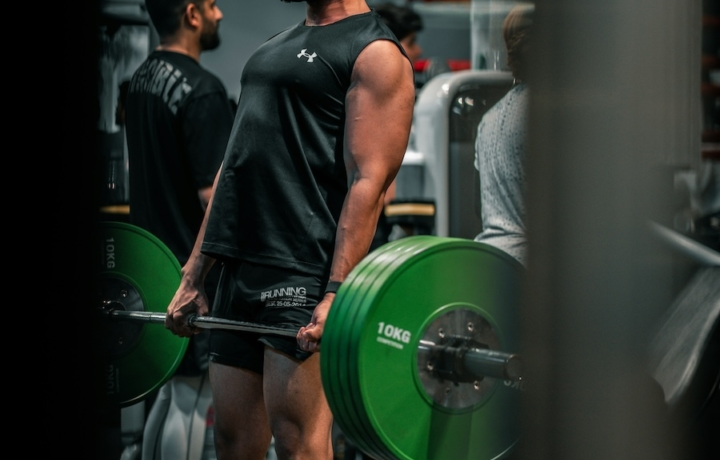Exercise
Dumbbell Glute Bridge

Dumbbell Glute Bridge
How to Perform
- Lie flat on your back with knees bent and feet planted hip-width apart, placing a dumbbell horizontally across your hips, holding it stable with both hands.
- Engage your core by drawing your navel toward your spine while maintaining a neutral position in your lower back.
- Press your feet firmly into the floor and squeeze your glutes to drive your hips upward until your body forms a straight line from shoulders to knees, exhaling during this upward movement.
- At the top position, ensure your weight is distributed evenly across your shoulder blades and feet while keeping your chin slightly tucked.
- Hold the peak contraction in your glutes for 1-2 seconds, maintaining tension throughout your posterior chain.
- Lower your hips back to the starting position in a controlled manner while inhaling, without allowing the dumbbell to press into your abdomen.
- Allow your hips to gently touch the floor without fully releasing tension in your glutes and core between repetitions.
- Keep your knees tracking in line with your toes throughout the movement, preventing them from caving inward or flaring outward.
Important information
- Place the dumbbell just below your hip bones, not directly on your stomach or pelvis bones where it could cause discomfort.
- If your hamstrings cramp during the exercise, try positioning your feet slightly further from your glutes.
- Avoid overarching your lower back at the top position — your goal is a straight line from shoulders to knees, not maximum extension.
- Start with a lighter dumbbell until you master the movement pattern, then progressively increase the weight as your glute strength improves.

Dumbbell Glute Bridge
Exercise Details
Primary Muscles
Muscle Groups
Mechanic
Risk Areas
Built for progress
Take the guesswork out of training
Create personalized AI-powered workout plans that evolve with you. Train smarter, track every rep and keep moving forward, one workout at a time.






The Dumbbell Glute Bridge is a fantastic beginner-friendly exercise that primarily targets your glutes while also engaging your hamstrings. This accessible movement requires minimal equipment yet delivers maximum results for anyone looking to strengthen their posterior chain.
This exercise serves multiple purposes in your fitness journey. For bodybuilders, it helps develop the aesthetic rounded shape of the glutes that's highly sought after on stage. During recovery phases, the controlled nature of the movement allows for blood flow to the area without excessive strain. As a warm-up exercise, it activates these powerful muscles before more demanding workouts, potentially reducing injury risk during heavier training.
What makes the Dumbbell Glute Bridge particularly effective is how it isolates the glute muscles through a full range of motion while providing adjustable resistance. By placing a dumbbell across your hips, you can progressively overload the muscles as they adapt and grow stronger. The exercise creates significant time under tension in the fully contracted position, which research suggests is optimal for muscle development.
The beauty of this movement lies in its versatility. You can perform it anywhere with minimal space requirements—at home, in a hotel room, or at the gym. For beginners, it offers a safe way to develop foundational strength in the posterior chain, which translates to improved performance in compound movements like squats and deadlifts.
Regular incorporation of Dumbbell Glute Bridges into your routine can address common muscular imbalances caused by prolonged sitting, potentially alleviating lower back discomfort and improving posture. The exercise also engages your core stabilizers as they work to maintain proper pelvic positioning throughout the movement.
For optimal results, focus on the mind-muscle connection rather than simply moving weight. The sensation of your glutes powering the movement is far more important than the amount of resistance used, especially when first mastering this effective strength-building exercise.
FAQ - Dumbbell Glute Bridge
The Dumbbell Glute Bridge primarily targets your gluteus maximus (the largest glute muscle) while also engaging your hamstrings and core. Your lower back and hip flexors work as stabilizers throughout the movement.
Start with a light dumbbell (5-10 lbs) to master the movement pattern before progressing. The ideal weight allows you to maintain proper form for 8-12 reps while still feeling challenged in your core, not your arms or shoulders.
To increase difficulty, try elevating your feet on a bench, extending the time under tension by holding the top position for 2-3 seconds, using a single leg variation, or simply increasing the dumbbell weight. These modifications will intensify glute activation and stimulate further growth.
The most common mistakes include excessive lower back arching, pushing through your heels instead of your mid-foot, rising too high (hyperextending), and not achieving full hip extension at the top. Focus on controlled movement with your core engaged to maintain neutral spine alignment.
For optimal results, incorporate Dumbbell Glute Bridges 2-3 times weekly with at least 48 hours between sessions to allow for recovery. You can perform 3-4 sets of 10-15 reps as part of a lower body workout or as a targeted glute-specific exercise.









